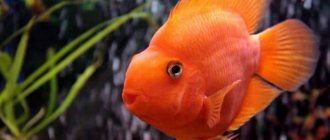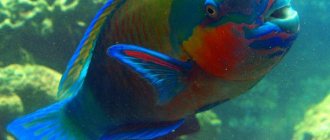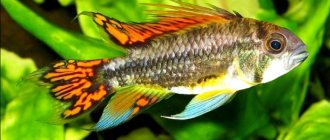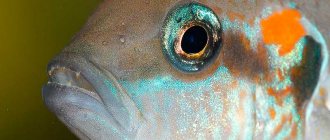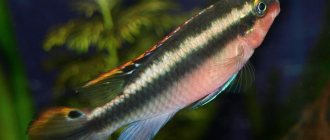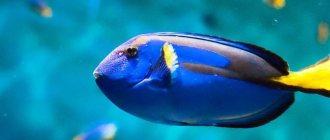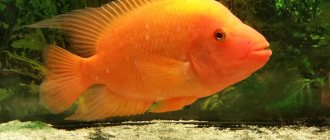The red parrot (English: blood parrot cichlid) is an unusual aquarium fish that was bred artificially and does not occur in nature. It is characterized by a barrel-shaped body, large lips folding into a triangular mouth and a bright, uniform color. In English-speaking countries it is called Red Parrot Cichlid, in our country it is also called a three-hybrid parrot. Do not confuse it with another cichlid, a small and colorful fish, Pelvicachromis pulcher, which is also called the parrot.
Cichlids are not picky about their partners, and they create pairs with their own kind and with other species of cichlids. This feature made it possible to obtain many hybrids from different types of fish.
Not all of them turn out successful, some do not shine in color, others, after such crossing, themselves become infertile. But there are exceptions...
One of the well-known and popular fish in the aquarium is the trihybrid parrot, precisely the fruit of artificial crossing. Also the Flower Horn, he is a child of genetics and the persistence of Malaysian aquarists. It is unclear exactly which cichlids this fish came from, but apparently a mixture of cichlids from Central and South America.
The red parrot aquarium fish will be a wonderful purchase for lovers of large, noticeable fish. They are shy and should not be kept with large, aggressive cichlids. They love aquariums with many shelters, rocks, and pots, into which they retreat when frightened.
Introduction
According to one of the literature sources, the red parrot cichlid is a hybrid obtained by crossing a female Rainbow cichlasoma (Cichlasoma synspilum) with a male Citron (lemon) cichlasoma (C. citrinellum).
The color of adults varies from solid to "calico" or spotted. The color range is quite wide: from light beige or bright yellow to orange or red. In addition, you can find individuals with shades of purple, pink, blue and other colors. They are commonly called "speckled parrots" or "striped parrots" (English: Jellybean Parrot and Bubble Gum Parrot). Some names directly reflect color, for example, “purple parrot.” Finally, the names of some varieties are derived from the shape of the body. For example, the “Love Heart Parrot”, due to the absence of a tail fin, has a shape reminiscent of a heart.
This hybrid is great for beginners and experienced aquarists. The fish have a soft and friendly character, so they should not be kept together with aggressive species. However, if you are going to place the fish in an aquarium with other inhabitants of the same size, you need to remember that the red parrot can be territorial. This fish prefers a rocky bottom with depressions, crevices and caves, which they use as shelters. Vegetation is not a requirement, but its presence does not pose a threat to the parrot.
The red parrot should not be confused with the cichlid Hoplarchus psittacus, which is another South American cichlid species that is often aggressive. It is also not related to the saltwater striped parrotfish, Scarus rivulatus (formerly Callyodon fasciatus). There is also a fairly popular hybrid - the Flower Horn cichlid. This is a very beautiful fish, but it is very different from the listed “parrots”.
Where does the parrot fish live?
Photo: Male parrot fish
The habitats of “colorful” fish are shallow reefs of the Pacific, Indian and Atlantic oceans, as well as the Mediterranean, Caribbean and Red seas. You can find both single fish and small groups swimming at shallow depths, from approximately 2 to 20 meters.
Each fish has its own separate shelter, which it defends. Therefore, when they gather in small flocks in their area of the reservoir, they drive away any stranger who encroaches on their domain. This moment is very important for them, since in their “house” they hide at night from other dangerous sea animals.
Dive divers often encounter them near coral reefs because this is their favorite habitat. Divers film them and take photographs. These fish swim slowly, making them very suitable for filming. They can only be seen during the day, as at night the fish hide in their “houses”.
Unfortunately, such fish cannot be kept at home. Due to the specific structure of teeth, which require special biomaterial for grinding teeth. And these can only be reef-forming corals, which humans are not able to constantly supply fish with.
The only places, other than diving sites, where you can see and examine this fish nearby are large aquariums. There they are supplied with everything necessary for the fish to feel like they are in their habitat. And anyone can see such beauty up close.
Habitat/Genesis
Individuals that do not have bright colors are called Jellybeam Parrot or Bubble Gum Parrot. These fish either have no color at all (albinos), or it is very weakly expressed; they are specially painted pink, purple, blue and other colors. The names of other fish are dictated by their natural color: for example, there is such a species as the purple parrot. On artificially colored individuals, the spots are often randomly located; it is not recommended to buy them. Staining is carried out by subcutaneous injection of dye. As a rule, the color after this procedure lasts for several months. Fish that have been subjected to such artificial coloring are susceptible to various diseases and die early.
Artificially colored Red Parrots( www.practicalfishkeeping.co.uk)
It is believed that the red parrot was bred in Taiwan, and its ancestors are cichlids living in Central and South America. However, there is still no consensus regarding the ancestors. There are two groups of probable ancestors, as a result of crossing which these hybrids were bred:
First generation: Among the most likely representatives are two Central American cichlids: Lemon cichlid (Amphilophus citrinellus; formerly Cichlasoma citrinellum) and Rainbow cichlid or Red-headed cichlid (Paraneetroplus synspilus; formerly Cichlasoma synspilum). This assumption is supported by the work of Chinese researchers who crossed female Rainbow Cichlasoma (Cichlasoma synspilum) with male Citron (Lemon) Cichlasoma (C. citrinellum) and obtained offspring of Red Parrots.
In this work, the percentage of fertilization and hatching after hybridization was 91.33% and 91.67%, respectively.
The fertilized eggs had an oval shape (length 1.89 mm) and a sticky shell. Their color varied from light white to white-gray and red-brown without fatty inclusions. At a water temperature in the aquarium of 30°C. 5 degrees, the incubation period was 52 hours and 32 minutes. The length of the larvae was 3.71 mm, and the length and width of the yolk sac were 1.74 and 1.25 mm, respectively. The larvae began to feed on rotifers on the third day, although the yolk sac was completely absorbed only on the fifth day. On the 13th day, the length of the fry was 11.86 mm and most of the fin rays appeared, indicating the transition from the larval stage to the fry stage (SUN Zhijing et al., 2014).
Other likely progenitors are the Central American Red Devil Cichlid (Cichlasoma labiatus) and one of the two South American cichlids, the striped Severus heros, or the Blue Cichlasoma (Cryptoheros spilurus; formerly Cichlasoma spilurum). These red parrot hybrids are very peaceful and shy. This behavior is characteristic only of South American severums.
Second generation: The next species of "red parrot" bred is "Convict Parrot Cichlid". It is a hybrid of a female red parakeet and a male pink parakeet (Amatitlania nigrofasciata; formerly Archocentrus nigrofasciatus and Cichlosoma nigrofasciatum, respectively). Some of these fish have also been artificially colored (Jellybean Parrot and Bubble Gum' Parrot). There is information that the Red Parrot was crossed with other cichlids - severum (Heros severus) and Texas cichlasoma (Herichthys cyanoguttatus; formerly Cichlasoma cyanoguttatum)
Perhaps new hybrid varieties will appear soon. In his Encyclopedia of Exotic Tropical Freshwater Aquarium Fish, Glen. S. Axelrod, Brian M. Scott and Neil Pronek exchange views with various aquarists. According to their statements, “some aquarium fish breeders believe that interbreeding contributes to the accumulation of scientific information about fish and their reproduction; others are convinced that interfering with nature is unethical and presumptuous, and that there are already more than 20,000 species of fish in nature, therefore, there is no need to create new species.” Also, there is an opinion that the desire to highlight any physical characteristics can lead to unpleasant consequences.
Scientific name: Social hierarchy: no natural communities found. Red Book data: none.
Appearance
The red parrot has a characteristic body shape that resembles a balloon. The mouth is very small; Most likely, the name of the fish comes from its nose, which is shaped like a parrot's beak. There are other distinctive features, such as a curved spine, which gives the body a unique shape, as well as a very large iris. Body shape features affect the bite, so sometimes the mouth does not close completely, which makes eating difficult. Finally, due to its ovoid shape, the fish cannot swim naturally and its movements are constrained and clumsy.
These fish can have either a solid color or a patterned one - “calico”, or spotted; the color can vary from the usual gray or yellow to orange or red. There are artificially colored albinos, as well as individuals that initially have a weakly expressed color. They are most often called Jellybean Parrot and Bubble Gum Parrot, although some names, such as "purple parrot", directly reflect their coloring. There are also species whose name comes from their appearance, such as the "love heart parrot", which does not have a tail fin.
12 cm orange parrot (aqualandpetsplus.com)
Orange spotted parrot (en.wikipedia.org)
Further breeding resulted in the development of the Black-striped Parrot, which is called the 'Jellybean' Parrot or 'Bubble Gum' Parrot'. It was bred by “double hybridization” - crossing a female Red Parrot hybrid and a pink male Black-striped Cichlazoma. It has been reported that the Red Parrot has been crossed with other cichlids - Severum and Texas Cichlid. New hybrids may be developed in the foreseeable future.
Hybrids obtained by crossing the Red Parrot with the Flower Horn cichlid (parrotcichlid.com/)
All cichlids, including some wrasse and parrotfish, that live in salt sea water, have one thing in common - a well-developed pharyngeal group of teeth located in the lower part of the pharynx. Cichlids have sharp rays on the dorsal portions of the anal, dorsal, pectoral and ventral fins that deter predators. The front parts of these fins are soft, and with their help the fish can easily take the desired position in the water, despite the low speed of movement.
Unlike other fish that have two pairs of nostrils, cichlids have only one pair. To detect a smell, they take water into their nostrils, hold it for a while, then release it. This behavior is also typical for pomacentrids, which live in salt water and are considered close relatives of cichlids.
The parrot's body length is 20.32 cm. Life expectancy is 10 years.
The difference between a male and a female
Males and females are identical in color and pattern, but there are differences in size. Females usually grow to 15-17 centimeters, while males are slightly larger, around 17-20 centimeters. The male has a conical anal tubercle, while the female has a pear-shaped anal tubercle. These signs are most pronounced during the breeding season.
Feeding
Since the Red Parrot is an omnivorous fish, any live or non-living food will do. To maintain balance, it is recommended to feed your fish daily with high-quality flake or granular food. You can also use crustaceans - brine shrimp (both live and frozen) and bloodworms. For older “parrots”, live guppies and “goldfish” are suitable. Food rich in protein and beta-carotene helps maintain bright color.
Food preferences: omnivore Flake food: yes Tablet food: yes; Tablets that settle to the bottom are best. Live organisms (fish, shrimp, worms): as part of the diet. Before placing the feed dispenser into the tank, make sure it is absolutely clean. Vegetable food: as part of the diet Meat food: as part of the diet Feeding frequency: several times a day
Aquarium care
It is necessary to update the water weekly by 20-25%, depending on the planting density in the aquarium. Inadequate water quality control can cause illness and death of fish. The glass must be wiped from the outside with a sponge, and from the inside with a magnetic scraper. Once the algae has settled, remove debris from the bottom of the aquarium using a siphon. Be sure to remove uneaten food scraps.
Water change - weekly
For young individuals, an aquarium with a volume of about 114 liters is suitable, in which they can be kept for the first two years. For adult fish, you must purchase an aquarium with a volume of at least 208 liters. Fish feel comfortable with slow or moderate movement of water that needs to be filtered. Since fish leave a very large amount of food uneaten, it is best to purchase a filter with a large volume of filler. Red parrots prefer low to moderate lighting. Place a thin layer of dark sand mixed with rocks and roots at the bottom of the aquarium so that the fish can find secluded corners.
The soil should not be too hard, as fish like to dig in it. Plants usually do not bother fish, so they can also be placed in an aquarium.
With regular water renewal, the fish adapt well to life in the aquarium and no longer require complex care. With proper care, their lifespan can reach 10 years.
Minimum volume: for young individuals - 114 l; for adults – 208 l. Soil type - sand/gravel mixture Light level - moderate Water temperature - 21.1-27.8° C pH reaction - 6.5-8.0 Water hardness (in degrees) - 2-25 dGH Salinity - none Water flow intensity - low
Diseases and prevention
In general, if the recommended water parameters are observed, parrotfish practically do not get sick. But if the concentration of phosphates and nitrogen compounds is exceeded, then the fish can be seriously harmed.
Black spots
Unfortunately, dark spots on the body of parrotfish are not that rare. Possible reasons for this phenomenon:
- Too high nitrate content in water . You need to clean the soil with a siphon and replace up to 40–50% of the aquarium’s volume. Over time, the stains will disappear.
- Stress. The fish was moved to another body of water, its shelter was removed during cleaning, and “noisy” neighbors were added. Try to give your parrot the opportunity to experience a negative event in a secluded place. After adaptation, the spots will disappear.
Other diseases
Parrot fish often suffer from ichthyophthyriasis - the integumentary tissues are covered with whitish particles similar to semolina grains.
For treatment, use Sera costapur water conditioner, having previously cleaned the soil with a siphon and replaced up to 50% of the water.
The product is applied only at night, since in sunlight the active components decompose and do not have the proper effect on the water.
Sometimes parrotfish can behave strangely, for example, move poorly (sideways) around the aquarium or even lie down on the bottom.
This behavior is a consequence of banal overeating or a symptom of food poisoning.
If poisoning is suspected, the fish is quarantined and treated .
The methylene blue preparation is dissolved in water (until a light blue tint of the water is obtained), 0.5 g of kanamycin and half a metronidazole tablet (data are given for a 12–15 liter depositor). The water is changed daily.
Important! During quarantine, it is necessary to ensure good aeration of the seed tank.
Usually, a quarantine of 3–5 days is enough for the parrot fish to become satisfactory.
Red Parrot Compatibility
Considering that the ancestors of this hybrid are quite aggressive, it is not considered a social species. However, since the fish exhibits a peaceful and docile nature, it can be kept with other species of similar size. If you plan to keep your parrot with other cichlids, make sure that there are no aggressive individuals among them. The fish gets along well with angelfish, peaceful catfish such as plecostomus, corydoras and Indian glass catfish, as well as Acantophthalmus Kühl, viviparous swordtails and characins - tetras and dollar fish. It should be noted that some of these fish can be aggressive, so if you decide to keep the Red Parrot in a community aquarium, you need to monitor their behavior.
Usually the fish gets along well with other fish, but some individuals sometimes show aggression. Depending on the species kept in the aquarium in addition to red parrots, the following criteria for monitoring their interaction with other individuals can be distinguished: With individuals belonging to the same species: in minimal risk mode With other peaceful species (): in normal mode With moderately aggressive species ( ): in normal mode With aggressive species (): in high-risk mode With large, moderately aggressive species (): in high-risk mode With large aggressive predators (): in high-risk mode With slow-swimming and feeding species (): in normal mode With shrimp, crustaceans and shellfish: no risk With plants: no risk
Breeding
Although male parrotfish are sterile and are not capable of reproduction, as soon as the water temperature is slightly raised above 25 ° C, the instinct to reproduce immediately awakens in the fish and intensive nest building begins. At the same time, the red parrot is capable of digging quite large holes in the ground and significantly changing the topography at the bottom of the aquarium. During the mating season of the parrot fish, you can watch with interest the ups and downs of the family life of this fish. Sometimes females even lay eggs, however, males cannot fertilize them, and they remain non-viable. According to monopolistic companies that breed and supply red parrots, the fry of these fish are gray-black, but by about 5 months they acquire a bright orange-red color.
